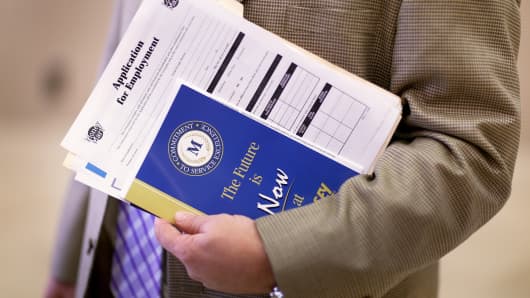The second reason is the impact of the globalization of the labor supply on unemployment rates. As the economy recovered, domestic hiring did not occur as it had previously. Consider the early-1980s recovery. In September 1983 alone, payrolls rose by 1.1 million. The manufacturing added 137,000 jobs that month and expanded by over one million workers from April 1983 to March 1984. That would never happen now since jobs go to both domestic and global workers. The unemployment rate was always going to fall slower than in previous recoveries.
(Read more: Yellen: Fed must promote very strong recovery)
The persistently high unemployment rate explains the largely nonexistent wage growth. The gap between the unemployment rate and full employment (NAIRU) is the largest since the early 1980s. Sharp job gains narrowed the spread rapidly in the past but not now. Instead, the multiple applicants for the same job minimize the current need to pay up for employees. Until the unemployment rate approaches full employment, real wage gains will not accelerate.
The Fed's trigger for an increase in the fed-funds rate (the rate banks charge each other) is an unemployment rate of about 6.5 percent, roughly one percentage point above full employment. That makes the unemployment rate a critical policy indicator. But that rate has come under a cloud because of the declining labor force participation rate. Those concerns are largely irrelevant.
(Read more: What the GOP really wants out of Yellen)
The sluggish recovery is not the prime cause of the falling labor force participation rate. The rate actually peaked in 2000. After 13 years, we can call that a trend and it was firmly in place before the lackluster recovery emerged. Indeed, the male rate has been declining for 65 years, while the female labor force participation rate peaked in 2000. Demographics and cultural norms explain this trend.
The second factor is the impact of extended unemployment rates on job search and participation rates. Between January 1960 and the onset of the Great Recession, the average duration of unemployment was 14 weeks. Since 2009, the average duration has been 34.5 weeks, reaching a peak of nearly 41 weeks in late 2011.
As long as people received benefits, they had to look for work. But they were then considered in the labor force and unemployed. Once benefits are terminated, the job-search decision becomes real and many people stop looking, i.e., stop participating in the labor market. That decision was delayed because of government policy.
(Read more: Has QE really boosted stocks?)
To the extent that extended unemployment benefits swelled the unemployment rolls and the labor force, both the labor force participation rate and unemployment rate were artificially elevated. As more people have become ineligible for benefits, the outflow from the labor force is as expected — it's accelerating. The conclusion: Part of the labor force participation-rate decline is a natural consequence of people who are losing benefits dropping out. The participation rate is moving down toward what it should have been.
But maybe the most compelling way to dismiss the labor force participation rate as an issue is to look at periods where the rate went up. Consider January 1977 and January 1981, the Carter years, when the labor force participation rate rose 2.3 percentage points. During that timeframe, the unemployment rate averaged 6.6 percent, only slightly above the 6.25-percent average for full employment (NAIRU).
If you want to discount the current downward trend in the unemployment rate, you would have to adjust the Carter period performance for the participation rate rise and conclude that was a period of outstanding economic activity. Arguing that people were better off after those four years would probably make Ronald Reagan turnover in his grave.
So what does this all mean? The unemployment-rate improvement is real. If the past two years are any indicators, by next November, the Fed's 6.5-percent target may be reached. At that point, wage gains should be accelerating, consumer spending improving and the talk of a rate hike rampant. Investors need to focus on that potential situation and stop stewing about the participation rate.
(Read more: Taper, no taper — Where does Yellen draw the line?)
— By Joel Naroff
Joel Naroff is president and chief economist at Naroff Economic Advisors.


